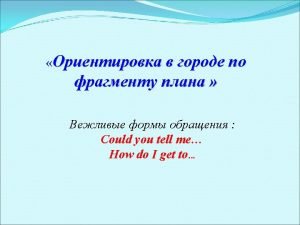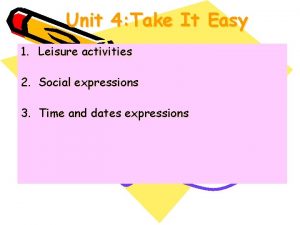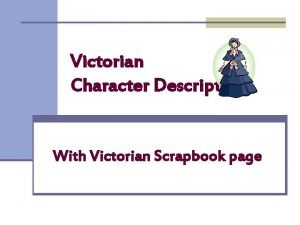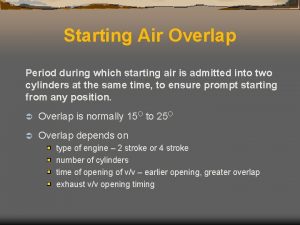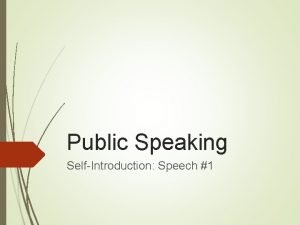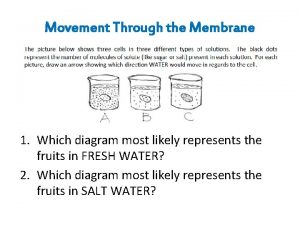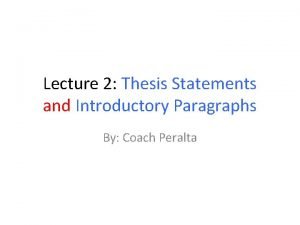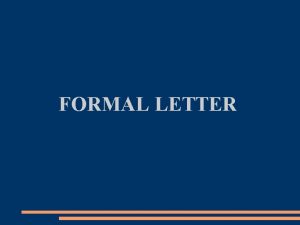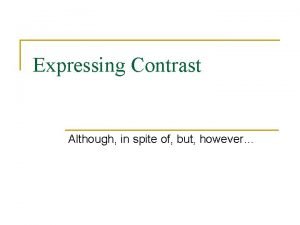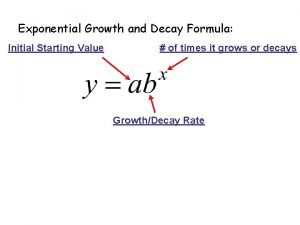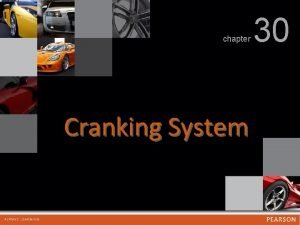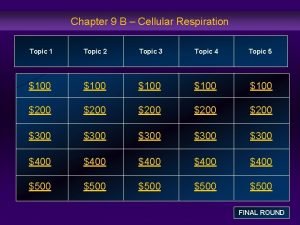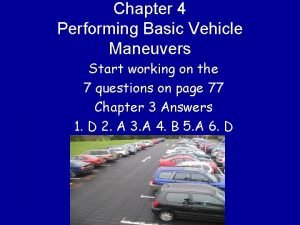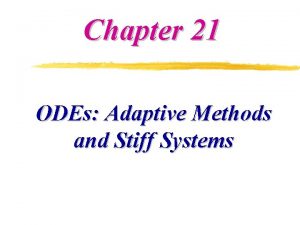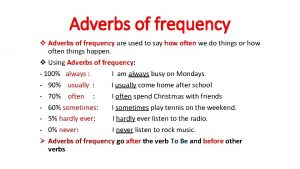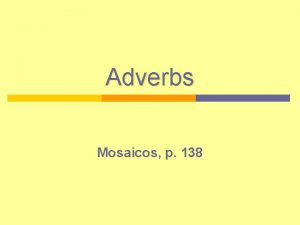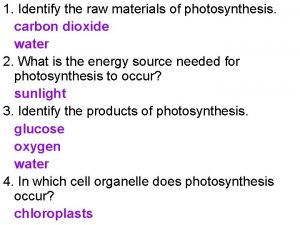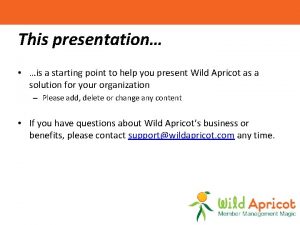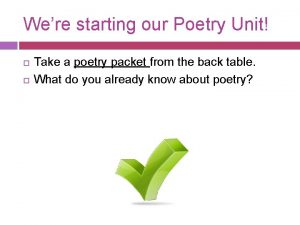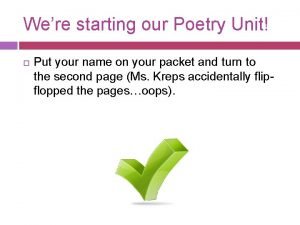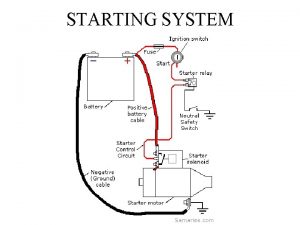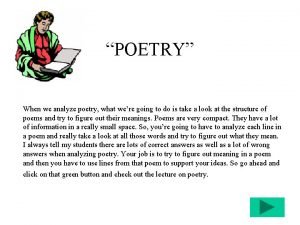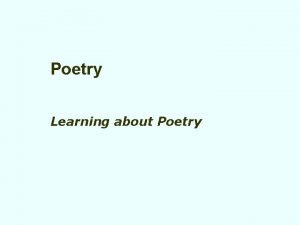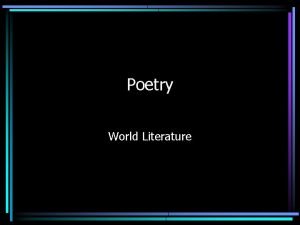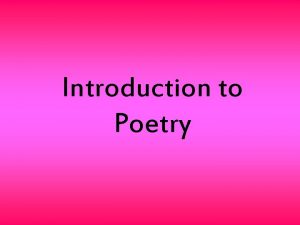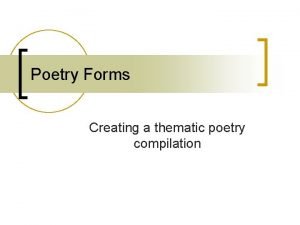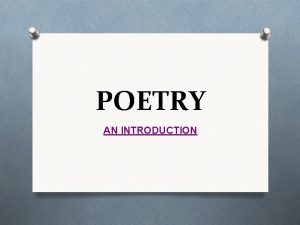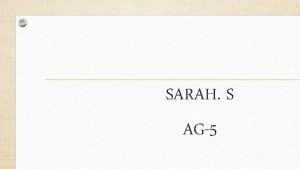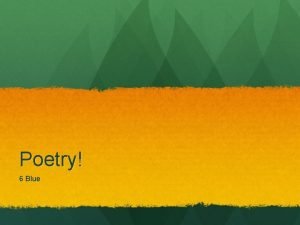Were starting our Poetry Unit Take a poetry














































- Slides: 46

We’re starting our Poetry Unit! Take a poetry packet from the back table. What do you already know about poetry?

Poetic Thoughts Example * ! ? #

Your Turn! * Do You Carrot All for Me? ! Do You carrot all for me? ? With your turnip nose My heart beets for you, And your radish face, You are a peach. # Lettuce marry: If we cantaloupe, Weed make a swell pear.

What is Poetry? In poetry, the sound and meaning of words are especially important. Poetry communicates experience and feelings. Brain Pop Poetry

Speaker The speaker is the narrator of the poem. It is not always the author. When we discuss poetry, we say, “The speaker might mean…”

Rhyme Rhyming words are words that make nearly the same sound. In poetry, rhyming words are used on purpose to create a certain sound or feeling. Example: �I don’t see the harm In visiting the farm. � The yellow eyes glowed by the side of the road.

Near Rhyme Near rhyme is also known as “close” rhyme or “slant” rhyme. It means that two words are very close to rhyming. Example: � He ran down the stairs Without a single care Never being scared

Rhyme Scheme The pattern of rhymes used in a poem The pattern can be labeled using letters Example: �A horse and a flea and three blind mice A Sat on a curbstone shooting dice. A The horse he slipped and fell on the flea. B “Whoops, ” said the flea, “there’s a horse on me!” B

Do you know any famous poets? William Shakespeare Robert Frost Maya Angelou (Brain Pop) � While you watch the video clip, think about the topics that inspire Maya Angelou to write her poems. What might inspire you to write a poem?

Free Verse A poem that does not have a rhyme scheme; line breaks are uneven and purposeful Example: �I walked along the side of the road A Looking for no one But I found a piece of myself along the way C B

Line Usually one row of words equals one line of poetry; it does not always end with punctuation How many lines are in this example? The Toaster A silver-scaled Dragon with jaws flaming red Sits on my elbow and toasts my bread. I hand him fat slices, and then one by one, He hands them back when he sees they are done.

Stanzas are the paragraphs of poetry. Types of Stanzas: � Couplet: A two-lined stanza that rhymes A squirrel climbed a tree Then he sang with glee � Quatrain: A four-lined stanza with a rhyme scheme The squirrel climbed a tree Then he sang with glee But soon, a bird swooped nearby It reached for him and let out a cry

Think about It What is poetry? Use your own words. (3 sentences)

Poetry Treasure Hunt You have 20 minutes to complete the treasure hunt. You may only have one book at a time. When you finish with your book, put it back on the chalk tray and take another one. You may keep one book the entire time or change books every few minutes. There is no talking during this activity. Treasure hunters do their best work in quiet areas.

If I was in Charge of the World… Let’s read the poem. Now you are going to create your own poem. What would you change if you were in charge of the world? Fill in the blanks with your ideas and be ready to share in 15 minutes. If you finish early, add a picture to your poem.

Couplet A poem that is made of stanzas with 2 lines each; the lines in each stanza must rhyme So precious are true friends who lend their ears And give their time to wipe away sad tears.

Thinking about Couplets Let’s read “My Brother Bert” together. Read the poem again to yourself and answer the 3 star questions.

Partner Work: Couplets Read “Sick” aloud with your partner; first one person will read it and then the other person will read it. On the left side of the poem, use at least 4 different symbols (* ! ? #) to show your thinking. On the right side of the poem, answer the questions.

How do I write a poem? Follow these steps!

Step 1: What’s the assignment? Read the directions. Always figure out the type of poem you are supposed to be writing. Then be sure to understand the requirements. Example: Write a 3 stanza couplet that includes at least one simile or metaphor.

Step 2: What should I write about? What’s your topic? You can write about anything that is school appropriate! Here are some sample topics: � seasons, etc. holidays, friends, family, school, sports,

Step 3: How do I start writing? When you think about your topic, what comes to mind? Use the graphic organizer to help you arrange things you already know about your topic. Make notes in the margins about things that you might want to include in your poem but don’t really fit into the graphic organizer.

Step 4: How do I put it together? To begin, write down your lines without worrying about rhyming. Then work on the rhyming part (find synonyms that do rhyme). Finally, add the required figurative language.

First Draft Example The freezing white snow landed on my cheek While I pulled my red sled down the driveway I could hear the laughter of children nearby As they ran to the giant hill The taste of hot chocolate was still on my

Step 5: How do I make it rhyme? The freezing white snow landed on my cheek While I pulled my red sled down the street I could hear the laughter of children nearby As they ran to the giant hill up high The taste of hot chocolate was still on my lips And my scarf was pulled tight around my neck And I could feel the weight of the sled on my hips.

Step 6: Figurative Language? The freezing white snow landed on my cheek While I pulled my red sled down the street I could hear children laughing like hyenas nearby As they ran to the giant hill up high The taste of hot chocolate was still on my lips And I could feel the weight of the sled on my hips.

Step 7: How do I make it perfect? The bitter white snow landed on my rosy cheek While I pulled my ragged red sled down the street I could hear children laughing like hyenas nearby As they scurried to the colossal hill up high The sweet taste of hot chocolate was still on my lips And I could feel the weight of the sled on my

Your Turn: Write a Couplet Figure out the rules for the kind of poem you are writing. Think of a topic and use the graphic organizer. Get your completed graphic organizer approved by me before writing your poem. Write your first draft; it doesn’t have to have the perfect words or perfect rhyme scheme yet. Use a thesaurus or a rhyme wheel to finalize your poem. Work independently. I won’t answer any questions for 15 minutes. You are smart, and

Quatrain with Questions A poem that is made up of stanzas with 4 lines each; the stanzas must have a set rhyme scheme The Joke You Just Told The joke you just told isn’t funny one bit. It’s pointless and dull, and wholly lacking in wit. It’s so old and stale, it’s beginning to smell! Besides, it’s the one I was going to tell.

Checking the Rhyme Scheme Have you ever seen a sheet on a river bed? A Or a single hair from a hammer’s head? Has the foot of a mountain any toes? And is there a pair of garden hose? B Does the needle ever wink its eye? Why doesn’t the wing of a building fly? Can you tickle the ribs of a parasol? Or open the trunk of a tree at all? Are the teeth of a rake ever going to bite? Have the hands of a clock any left or right? Can the garden plot be deep and dark? And what is the sound of the birch’s bark? A B

Thinking about Quatrains Let’s read “Have You Ever Seen? ” together. What makes this poem a quatrain? Now label the rhyme scheme with your neighbor. Begin only the first stanza with “A. ” The second stanza will begin with a different letter. It’s up to you to figure it out.

Analyzing Poems The poet of “Have You Ever Seen? ” loves to play with words. Our language is confusing! Can you make sense of it? Complete the chart.

Your Turn: Write a Quatrain Complete the prewriting. Then have me check it. Once approved, you may begin writing your three stanza quatrain. It must follow one of the rhyme schemes allowed, and it must include an example of personification and purposeful alliteration.

Free Verse A poem that does not have a set rhyme or rhythm; its main focus is on line break and the way words sound next to each other. Fog By Carl Sandburg The fog comes on little cat feet. It sits looking over harbor and city on silent haunches and then moves on.

Thinking about Free Verse Let’s read “Foul Shot” together. What makes it free verse poetry? Now read it again to yourself. Answer the 4 star questions and be ready to share in 10 minutes.

Thinking about Free Verse Read “Some Poems” to yourself. Choral Reading (I’ll read a section and you will repeat it!) Answer the 3 star questions with your neighbor. Be ready to share in 3 minutes.

Your Turn: Write a Free Verse Poem A free verse poem doesn’t have a rhyme scheme or rhythm. It must be at least 15 lines long. It must have an example of alliteration and another figurative language.

What’s a ballad?

Ballad A poem with a chorus and several verses; it usually tells a story and has a rhyme scheme Rolling in the Deep We could have had it all Rolling in the deep You had my heart inside your hand And you played it to the beat

Thinking about Ballads You’ve probably heard or read ballads hundreds of times. The core structure for a ballad is a quatrain, written in either abcb or abab rhyme schemes. They are simple stories told in poetic form.

What is the story in these ballads? Cats in the Cradle Love Story You Don't Know. . .

ip h s d n e i Fr Themes in Ballads s s e in p p Ha Time Love Exploration and Discovery Doing the Impossible Heartbreak

Analyzing Ballads Let’s read the next ballad together. How many stanzas are there? Lines? Which stanzas are the chorus? Complete the boxes on the right side of your paper. You are analyzing (breaking apart and looking at each piece) of the poem! Don’t you feel smart! You have 20 minutes. If you finish early, work on homework or

Reading Ballads Let’s read “City I Love” together. What do you think of our city? Where else might you like to live? Work with your neighbor to answer the 3 star questions. You have 7 minutes.

Your Turn: Write a ballad Use the graphic organizer to help get started. Write your ballad. You must have 2 verses, a chorus that is repeated, imagery, and a rhyme scheme. The chosen tone must be clear! Sign up for a Writing Conference:

Independent Poetry Practice Read “He Had a Dream. ” Answer the 5 star questions. Read “Earth, What Will You Give Me? ” Answer the 3 star questions. Check your answers with the key.
 Take a bus or take a train
Take a bus or take a train Thinking affects our language, which then affects our:
Thinking affects our language, which then affects our: Our census our future
Our census our future Bernadette farrell christ, be our light
Bernadette farrell christ, be our light Our life is what our thoughts make it
Our life is what our thoughts make it We bow our hearts we bend our knees
We bow our hearts we bend our knees Our census our future
Our census our future Our life is what our thoughts make it
Our life is what our thoughts make it Money madness is written by
Money madness is written by Awareness of ourselves and our environment is
Awareness of ourselves and our environment is Is our awareness of ourselves and our environment.
Is our awareness of ourselves and our environment. God our father christ our brother
God our father christ our brother Our future is in our hands quotes
Our future is in our hands quotes Our awareness of ourselves and our environment.
Our awareness of ourselves and our environment. Our awareness of ourselves and our environment
Our awareness of ourselves and our environment Unit 6 review questions
Unit 6 review questions There isn't a bank in our town
There isn't a bank in our town Future in the past was were going to examples
Future in the past was were going to examples Unit 4 take it easy
Unit 4 take it easy Thinking of starting a business
Thinking of starting a business Character traits starting with n
Character traits starting with n Qualities starting with n
Qualities starting with n Pony motor starting synchronous motor
Pony motor starting synchronous motor Overlap in starting air system
Overlap in starting air system Presentation starting speech
Presentation starting speech Fundamental and derived positions
Fundamental and derived positions Photosynthesis recipe card
Photosynthesis recipe card Tag essay example
Tag essay example Funnel method introduction example
Funnel method introduction example Formal letter format
Formal letter format Nevertheless
Nevertheless Exponential growth and decay
Exponential growth and decay Qualities starting with n
Qualities starting with n Chapter 30 engine starting systems
Chapter 30 engine starting systems Starting materials for cellular respiration
Starting materials for cellular respiration Chapter 4 performing basic maneuvers page 14
Chapter 4 performing basic maneuvers page 14 Heun method
Heun method Small busness
Small busness Checking accounts 101
Checking accounts 101 Air starting system working principle
Air starting system working principle Adverbs of frequency formula
Adverbs of frequency formula Adverbs for v
Adverbs for v Starting air system
Starting air system Identify the process
Identify the process When is mechanical energy conserved
When is mechanical energy conserved The starting point in a presentation
The starting point in a presentation Em spectrum song lyrics
Em spectrum song lyrics
















